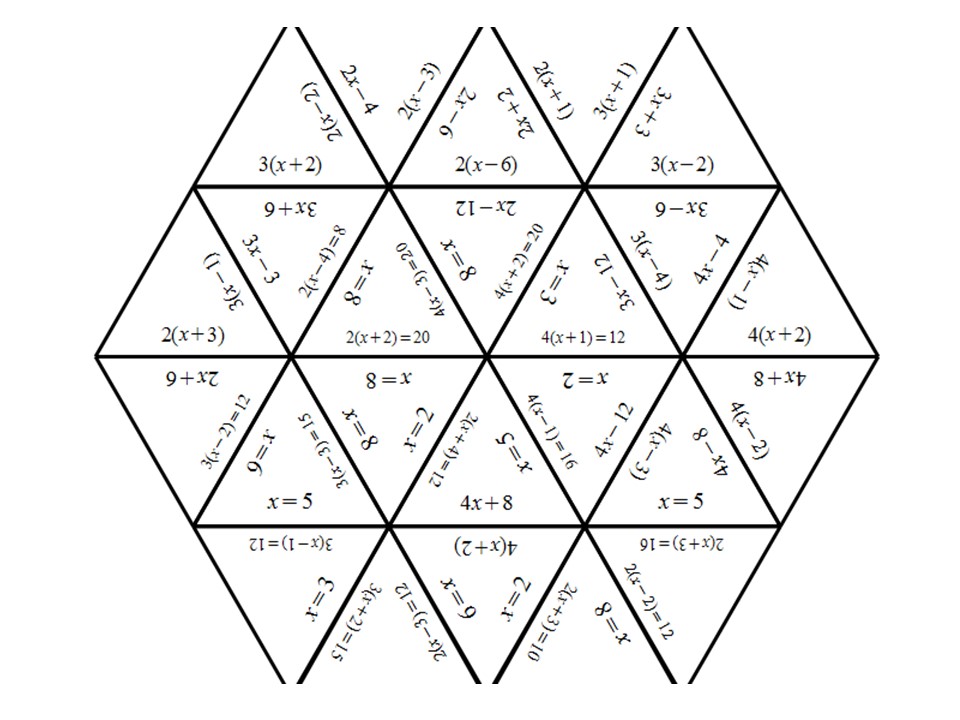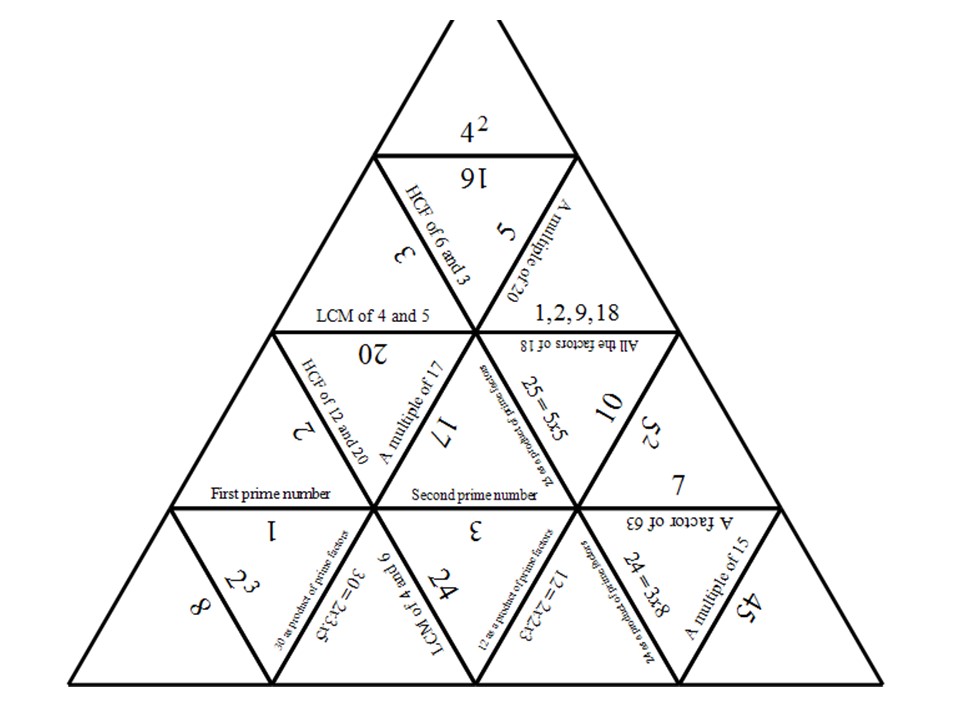Tarsia Jigsaws


On this page you will find links to all my Tarsia files, as well as hints and tips for making the most out of this amazing piece of free software.
Contents
Tarsia Troubleshootingkeyboard_arrow_up
Back to Top
Please, please, please do not email me if you have any problems
with the Tarsia Jigsaw software. I did not create the software, I
do not know how it works, I am not affiliated with it in any way,
I am merely a teacher who has written lots of free jigsaws using
it and wants to share them. Any technical problems, please contact
the creators, Hermitech Laboratory, via their website here.
Here are the solutions to some of the most common problems:
I get a load of random code when I try to open a jigsaw
Have you actually downloaded the free Tarsia Jigsaw software?
You can get it on the creator's website here.
I have the software, but the jigsaws won't open when I click on them via your website
You can get it on the creator's website here.Try clicking on
them, choosing Save instead of Open, and then opening them
directly in the Tarsia Jigsaw software itself by going to File
> Open.
That still did not work
Maybe try speaking to your tech people at work
I cannot display spaces between words on the jigsaw
On the Input screen, go to Style, and choose Text
I have a load of Tarsia Jigsaw files on my computer, but they won't open
Try opening the Tarsia Jigsaw software first, then opening to the
jigsaws from within the programme itself by going to File > Open.
Is there a version of Tarsia available for the Mac?
I do not think so, but again, please contact the creators.
I cannot add images to my Tarsia Jigsaws
It is possible to do this, but it is a bit tricky. This
blog post should help
How do I get the Tarsia Jigsaw Software?keyboard_arrow_up
Back to Top
What are Tarsia Jigsaw files?
Tarsia is a piece of freely available software which allows teachers to create a wide range of jigsaws, domino and follow-me activities very easily.
Why are Tarisas so great?
I have been using Tarisa jigsaws for the past 11 years of my
teaching because:
- You can easily create wide range of activities, including
jigsaws of various shapes and sizes, dominoes, matching
rectangular cards and follow-me cards.
- The teacher does not need to spend time cutting up the jigsaw as
the software automatically jumbles up the pieces of the jigsaw in
the Output section, thus allowing the teacher to simply print out
a copy and hand it to the students to cut out and assemble
- Key Point: There are plenty of ways of adding richness and
challenge to Tarsia jigsaw activities, as I explain in the
"Twists" section below.
How can I get the software?
The software is available to download for free from via this
link
Scroll down to the bottom of the page for “Formulator Tarsia
Installation Package”
If that link isn't working, then you can also get the installer
here
The license of use is
here
And here is a comprehensive user
manual
Screen shots and instructions are available via this
link
Using Tarsias the Standard Waykeyboard_arrow_up
Back to Top
Having selected what type of activity they wish to create,
teachers use the Input screen to input as many questions and
answers as they like. The software has a built-in equation editor
to ensure that all mathematical symbols and expressions are
available, and supports the importing of images. Teachers can then
check their answers on the Table screen, before printing out the
jumbled up version for the students. They can then either print
out the solution or project it onto their interactive whiteboard
for the students to check their answers. Completed jigsaws also
make nice classroom displays. Please see the bottom of this page
for a note about images in Tarsia Jigsaws.
Tarsia Jigsaw activities are incredibly versatile, and can be used
for many mathematical topics and all ability levels. They promote
group work and discussion, and provide a nice alternative to doing
questions out of a textbook. They are an ideal way to revise or
consolidate a topic. Furthermore, they can be differentiated – by
writing questions of varying difficulty, you can ensure that all
students can access some of the activity whilst also providing
extension material for the most able.
Tarsia Twists and Variationskeyboard_arrow_up
Back to Top
With a bit of tweaking, Tarsia puzzles can be made even more
challenging, pushing your students to think even more about the
topic in hand. Ideas include:
• Tarsia: Convince Me – in my opinion, this is the
ultimate way to use Tarsia Jigsaw activities! They work like this:
- Create a Tarsia (or adapt an original one) so that it contains
(at least) 5 mistakes, and ensure these mistakes highlight common
misconceptions students have with a particular topic
- Print off the solution slide and give it to your students (much
less photocopying and no needing for scissors!)
- The student must find (at least) 5 incorrectly matched up
elements, convince you that each one is incorrect explaining the
mistake that has been made, and then decide what the answer should
have been
- Better still, include a ? instead of an answer and challenge
students to replace the ? with the correct answer
- Include a ?? instead of a question, and challenge students to
come up with lots of different questions to replace ?? that could
give the answer. A selection of these questions can then be given
to other students to use as a rich, challenging, pupil-created
homework.
This can all be set out beautifully in their exercise book,
providing a challenging, rich, worthwhile activity :-)
Click
here for an example of a Tarsia Convince Me activity on
factors, multiples and primes
• "No Answers" Worksheet – one criticism of Tarsia is that
once the students have completed the puzzle they have no
record/evidence of their work and also no revision material. Gill
Hillitt has a solution... simply print out the "Table" page and
blank out the answers. Hand this out to the students alongside the
jigsaw and they can fill in their answers here as they go. When
the jigsaw has been completed, they then have a lovely record of
their work. Nice.
Top Tip: To blank out answers, delete them on the input screen,
but add a space (press the space-bar), otherwise you may find the
answer returns!
• Supplementary Sheets – make Tarsia jigsaws much more
versatile with supplementary sheets. These may involve pictures of
statistical diagrams to interpret, or even secrets codes to reveal
the mystery word. There are examples of all of these in my Tarsia
jigsaw collection.
• Distractors – when creating (or adapting) a Tarsia and
you are on the Input screen, there are tabs labelled "d1", "d2",
etc. Here you can place "distractors" - i.e. a question that does
not match to any of the answers, or an answer that does not match
to any question. These will always land on the outside of the
final, successfully completed jigsaw, and provide an excellent
extra challenge for students.
• Missing Answers – choose a couple of the cards and leave
the answer (or even the question!) blank so students have to fill
them in for themselves
• Deliberate Mistakes – announce at the start of the
activity that you have made two mistakes (or better still, a
mystery number of mistakes!) in the puzzle and students must
assemble the jigsaw, identify the mistakes, and correct them
• Non-unique Solutions – have a couple of the answers the
same, so students have to use logic and thinking skills to
assemble the entire puzzle correctly
• Order of Difficulty – when students have finished the
puzzle, get them to select the three most difficult pieces to
match-up and explain what makes them tricky
• Revision Lessons – get students to create Tarsia puzzles
themselves on difficult topics (it is a free piece of software so
can be installed on all school computers) and challenge each other
to solve them
Tarsia Top Tipskeyboard_arrow_up
Back to Top
1. Leaving spaces between text
You may have discovered that if you try to type words into the Tarsia jigsaw input screen (e.g. "I Love Maths"), when you come to print the jigsaw, they appear all together, with no spaces, like this: "ILoveMaths". To solve this, you need to go to Style in the top toolbar, and change from Math to Text. That should solve the problem.
2. To blank out answers
Very useful for creating worksheets as discussed above. Simply
delete answers on the input screen, but add a space (press the
space-bar), otherwise you may find the answer returns!
3 . Handling images in Tarsia and sharing them:
Good news – you can insert images into Tarsia. Bad news - Tarsia
does not insert an image instead it inserts a link to the absolute
address of the image. This means that if the images are then moved
the jigsaw will lose contact and you will end up with those
annoying red rectangles.
This is fine if you are creating a jigsaw to be shared on a
network, so long as you first put all the images you want to use
where they can be accessed by everyone you want to share with.
However, if you wish to simply copy a jigsaw which contains
images, then not only do the images need to be copied to where
they will be accessible but also all the links will need to be
changed! Alas, I have found no way of getting around this. You can
find more details on adding images to Tarsia courtesy of Alan
Catley by clicking here.
However, there is an alternative! Once you have placed the images
in your Tarsia, you can convert Output page(s) into a pdf. This
will then retain all your images, enabling you to share the file
much more easily. The downside is that you won't be able to edit
the Tarisa as it will be locked in the pdf, but this might be an
ideal solution to get round the image issue. A nice, free pdf
converter is PrimoPdf.
Mr Barton's Tarsia Jigsaw Fileskeyboard_arrow_up
Back to Top
Please Note: I have organised all my Tarsia Jigsaws for Key Stage 3 and GCSE so they are categorised under the relevant subject area. You can find them all under the Lessons section of the Topic you are looking up.
As ever, if you have any Tarsia jigsaws to share, please email me!
Additional Tarsia Jigsaw Bundles:
Stats
1
Stats
2
Stats
3
Stats
4
Stats
5
Tarsia Key Contributorskeyboard_arrow_up
Back to Top
These jigsaw files are proving immensely popular and extremely
useful, so if you have any of your own jigsaw files which you
would like to share, then please drop me an email at
[email protected] . The more the merrier! Thank you...
Many thanks to the following people for kindly donating their
jigsaws to the bundle:
Peter Brooks, Plant Hill Arts College,
Manchester
Judith de Villiers, Folkestone Academy, Kent
Steve Wren, Comberton Village College,
Cambridge
Nisha Ganatra, Lea Manor High School, Luton
Samantha Green, The Cheltenham Ladies College,
Cheltenham
Susan Verity
John White, Secondary Maths Consultant, Swindon
Karen Walker, Poltair School, St. Austell
Jenny Andrews, Richard Hale School, Hertford
Sam Powell, Sheldon Heath Community Arts
College, Birmingham
Nyima Drayang, Seaham School of Technology
William Leonard, Bullerswood, Bromley
Vikki Sutton, Holmesdale Technology College
Paul Tyreman
James Gatrell, St John Plessington Catholic
College
Kevin Alderson, Newcastle College
Gill Hillitt, Joseph Chamberlain College,
Birmingham
Sarah Pearson, Taipei Eurpoean School
Simon Young, Erith School
Steve Sherman and Pupils, Tytherington High
School
Alan Catley
Your contributions are very much appreciated!